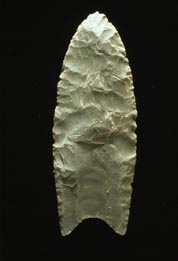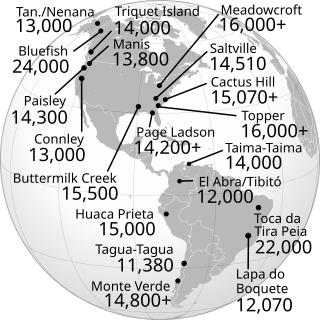Clovis culture
prehistoric culture in the Americas c. 13,000 – 11,000 BP From Wikipedia, the free encyclopedia
Remove ads
The Clovis culture was one of the first well documented Native cultures in the Americas. The Clovis people lived in the Americas about 13,000 years ago. They lived there for between 200 and 800 years. Different sources list different lengths of time in that range.

They had a special way of making tools like spear tips and knives from stones. The flint tips are called Clovis points. Artifacts that they made in this way can be found in many places in North America. The Clovis way of making tools only lasted between 500 and 1000 years. After that, other similar ways became more popular.
They are called "Clovis culture" because archaeologists first found their artifacts at Clovis, New Mexico.
Remove ads
The end of the Clovis culture
A decline in the availability of megafauna, together with the population becoming less and less mobile, led to local differentiation of lithic and cultural traditions across the Americas.[1][2] After this time, Clovis-style fluted points were replaced by other fluted-point traditions (such as the Folsom culture).[3]
Clovis First (a theory)
The Clovis First theory says that the Clovis people crossed the Beringia land bridge over the Bering Strait from Siberia to Alaska during the period of lowered sea levels during the ice age, then made their way towards the south, through an ice-free corridor east of the Rocky Mountains in present-day Western Canada as the glaciers retreated.[4]
Things that point to earlier settlement of the Americas
"Clovis First" is one of the theories about the Settlement of the Americas. There are other ideas and research that go against "Clovis First".
- Evidence of human habitation before Clovis
- Idea about a coastal migration route: Research on the mitochondrial DNA of First Nations/Native Americans, was published in 2007. It suggests that the people of the New World may have diverged (or went away from each other and stayed away), genetically from Siberians as early as 20,000 years ago.[5] One theory says that the Pacific coast of North America may have been free of ice, and maybe the first peoples in North America came down this route before the formation of the ice-free corridor.[6]
- Solutrean hypothesis
- Genetic history of Indigenous peoples of the Americas: Research on mitochondrial DNA in 2014 has found that members of some native North American tribes have a maternal ancestry (called haplogroup X) that has a link to the maternal ancestors of some present-day individuals in western Asia and Europe - but the link is not strong. A variant of mitochondrial DNA called X2a found in many Native Americans has been traced to (or research shows that the variant comes from) western Eurasia, while not being found in eastern Eurasia.[7]
Research that shows human habitation before the Clovis culture

Archaeological sites that have been shown to be older than the Clovis culture:
- Hartley mammoth butcher site, Colorado (38,900–36,250 cal BP by AMS 14C analysis of hydroxyproline from bone collagen)[8]
- Bluefish Caves, Yukon, Canada (24,000 years BP)[9]
- White Sands National Park, New Mexico, USA; (21,000-23,000 BP)[10][11][12]
- Pedra Furada, Piauí, Brazil (10,500–12,000 yr BP; possibly older than 50,000 yr BP)[13][14]
- Topper, South Carolina, US (16,000–20,000 yr BP; possibly 50,000 yr BP)[15][16][17]
- Meadowcroft Rockshelter, Pennsylvania, US (16,000 yr BP)[18]
- Buttermilk Creek Complex, Salado, Texas, US (15,500 14C yr BP)[19][20][21]
- Cactus Hill, Virginia, US (15,070 14C yr BP)[22]
- Monte Verde, Chile (18,500 to 14,800[23] 14C yr BP)[24][25]
- Saltville (archaeological site), Virginia, US (14,510 14C yr BP)[26]
- Taima-Taima, Venezuela (14,000 yr BP)[27]
- Manis Mastodon Site, Sequim, Washington, US (13,800 yr BP)[28]
- Connley Caves, Oregon, US (13,000 yr BP)[29]
- Page-Ladson, Florida, US (14,550 cal yr BP])[30]
- Lapa do Boquete, Brazil (12,070 ±170 14C yr BP)[24][31]
- Paisley Caves, Oregon, US (14,300 cal yr BP)[32]
- Tanana Valley, Alaska, US (13,000–14,000 cal yr BP)[33]
- El Abra, Colombia (12,460 ±140 14C yr BP)[24]
- Nenana Valley, Alaska, US (12,000 yr BP)[34]
- Tibitó, Colombia (11,740 ±110 14C yr BP)[24]
- Tagua-Tagua, Chile (11,380 ±380 14C yr BP)[35]
Remove ads
References
Wikiwand - on
Seamless Wikipedia browsing. On steroids.
Remove ads
